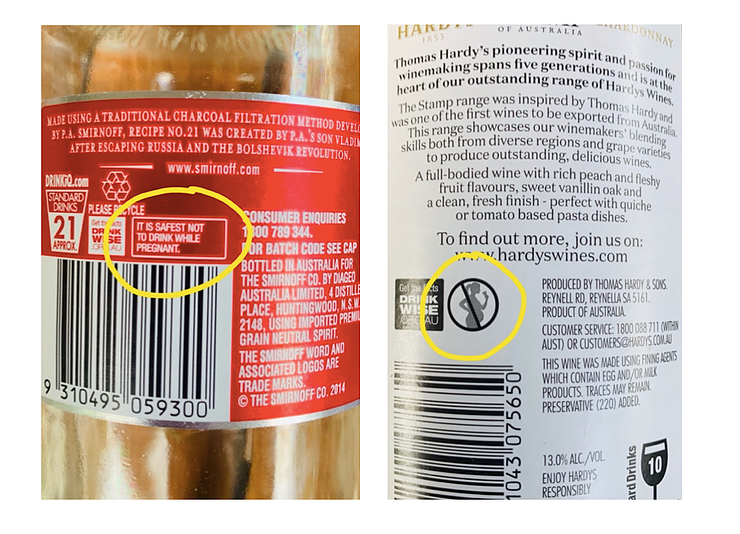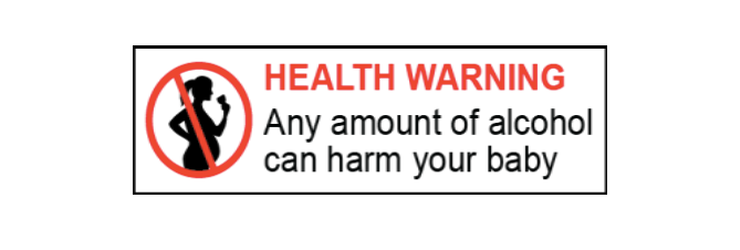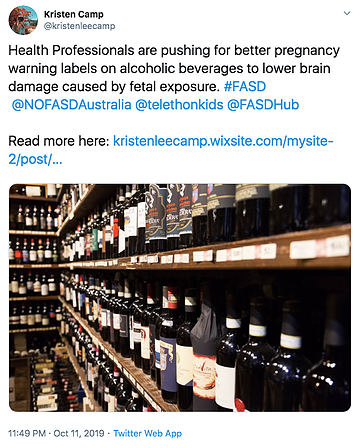Health Professionals are pushing for better pregnancy warning labels on alcoholic beverages to lower brain damage caused by fetal exposure.
Fetal Alcohol Spectrum Disorder (FASD) is a permanent brain injury caused by prenatal alcohol exposure and is the leading cause of birth defects, developmental and learning disability worldwide.
Despite the efforts of health professionals and FASD organisations, statistics show that 50-60 per cent of Australian women still drink alcohol while pregnant.
With no conclusive evidence to say what amount is a ‘safe level’ of alcohol consumption, expectant mothers are being advised to refrain from drinking at all, in order to avoid harm.
Chief Executive at the Foundation for Alcohol Research and Education (FARE), Michael Thorn says the lack of understanding regarding this issue, leads to around 75,000 alcohol-exposed pregnancies annually.
“Unfortunately a number of myths still exist about alcohol consumption during pregnancy, including that ‘one drink won’t hurt’ – but the reality is that there is no safe time, no safe type of alcohol and no safe amount of alcohol during pregnancy,” Mr Thorn says.
Mr Thorn says the alcohol companies are partly to blame for considering women as a ‘growth market’ and not taking action on their end.
“There is a dangerous trend of alcohol brands deliberately targeting women with marketing and social memes suggesting they ‘deserve’ a drink,” he says.
Due to the drinking culture in Australia, the country has one of the highest rates of alcohol consumption during pregnancy in the world.
The older demographics are the worst offenders, with around half of pregnant women aged 36 or older continuing to drink while aware of their pregnancy.
Younger mothers are a lot more cautious, as 90 per cent of women aged 25 or under stopped drinking as soon as they found out they were pregnant.
General Practitioner and AMA Federal Councillor Dr Richard Kidd has been pushing for mandatory labelling to appear on all alcoholic beverages, warning women that alcohol is the 100 per cent preventable cause of FASD.
“We’re still fighting because the alcohol industry doesn’t want that, they would happily keep selling it, even to women who are pregnant and don’t know the danger,” he says.
Dr Kidd says other countries have required clear warnings on their alcohol packaging for years, with America introducing them in 1989.
“France has got a very nice one … they’ve got a silhouette of a lady with a nice big pregnancy bump, holding up what looks like red wine and a red line through it.
“So you know it doesn’t need any words, it’s a very clear, simple logo that’s a nice warning,” he says.
Mr Thorn says the Australian alcohol industry has failed in their attempts to provide adequate pregnancy warning labels on alcohol products.
“After seven years of voluntary application by the alcohol industry, 52 per cent of all packaged alcohol products available for sale still did not have a pregnancy warning,” he says.
In 2018, Food Standards Australia and New Zealand were asked to consider mandatory warning labels on all alcoholic beverages and have recently released a proposal of a label design and implementation strategy.

The new regulations will change the wording of the warning from ‘It is safest not to drink while pregnant’ to ‘Any amount of alcohol can harm your baby’, which was shown through survey to be a more effective and convincing statement.
The size will also be enlarged and it will be compulsory for the circle and diagonal strikethrough to be coloured red, to attract attention and enhance recognition.

If the proposal is approved, it will hopefully discourage drinking at the point of sale and the point of consumption, as well as encourage societal conversations surrounding the consequences.
However, it will take a transition period of up to two years to be implemented.
There are a range of other ways that pregnant women can be educated about FASD and one of the most significant is through their local GP.
While health specialists like Dr Kidd are confident about having the conversation with their pregnant patients, data shows that 64 per cent of medical professionals feel that asking about alcohol use during pregnancy may make parents feel judged or blamed.
Despite this, FARE’s Women Want to Know campaign highlights that 97 per cent of women want to be asked about alcohol consumption and 91 per cent think health professionals should advise women not to drink while pregnant.
Women Want to Know aims to overcome the current barriers and educate health professionals, to avoid conflicting messages and insufficient information being given to pregnant women.
Another of FARE’s campaigns, Pregnant Pause, is encouraging women and their partners to ‘make the pledge’ and go alcohol-free during pregnancy.

Research shows that Australian women would be less likely to drink while pregnant if their partner was to stop with them.
Mr Thorn says while the father’s alcohol use during the conception period does not directly contribute to FASD, studies are suggesting that it affects the sperm quality and may have a role in causing future health problems.
“The safest option is for both parents to refrain from using alcohol during preconception and pregnancy,” he says.
With more FASD affected children being born than Autism, Cerebral Palsy, Spina Bifida, Down Syndrome and SIDS combined, it is a condition that occurs in all sectors of society.
Despite its prevalence among Australians, FASD is still so stigmatised and under-recognised, causing it to rarely be diagnosed.
Senior Principal FASD Researcher Professor Carol Bower says early diagnosis is preferable as it can allow early intervention and prevention of the consequences later on.
With organisations like NOFASD (National Organisation for Fetal Alcohol Spectrum Disorder) and FARE working to promote prevention and management, it is contributing significantly to the awareness surrounding the issue and opens up the conversation to the public.
As a society, we should be discussing the outcomes of fetal alcohol exposure more frequently and considering ways we can all help to improve the number of babies affected.
For more information about anything FASD related you can visit the following websites:
NOFASD: https://www.nofasd.org.au/
FASD Hub: https://www.fasdhub.org.au/
FARE: http://fare.org.au/policy/fasd/
Social media: #FASD #NOFASD #FARE #ALCOHOL #AWARENESS #PREGNANCY

This article was first published by Kristen Camp on 12 October 2019.








Add comment